Why should I steward my own property?
While the stewardship of our conservation areas and easements is incredibly important, protecting the natural areas of Skagit County actually starts at home with you!
| Making your yard or garden more environmentally friendly has numerous benefits. It can provide habitat for wildlife, create wildlife corridors between urban areas and wild spaces, conserve our water resources, and limit the spread of invasive weeds – which are often unintentional escapees from peoples’ gardens. | 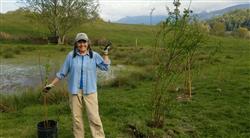 |
We’ve compiled a list of tips and resources to help you actively manage your property. Whether you’re just getting started or looking to take on some more site-specific stewardship tasks, this guide should help point you in the right direction!
Getting Started
Get to know your property
Understanding your property and the surrounding area is the most important step towards stewarding your land. Spend some time observing what the plant community and geographic features are in and around your property. Are you surrounded by urban areas and gardens? Is your property forested or bordering a creek, river, or the coast? These features can tell you a lot about how best to care for your property for the benefit of wildlife and to protect our natural resources. Looking at aerial images such as those on Google Maps can give you a more cohesive understanding of how the location of your land plays a role in the ecosystems of Skagit County. Most mapping programs also have a terrain view that lets you see contours in the landscape on your property.
Floodplain
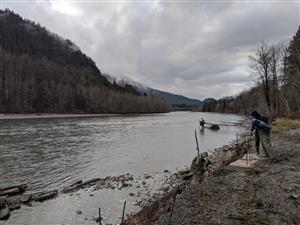 | If you live within the floodplain of a river or stream, your property may experience flooding. While flooding is an important natural process, it also impacts the landscape. If you live in a floodplain, you may find that floods deposit certain invasive species (including knotweed, butterfly bush, and yellow archangel) from upstream across your property. Walking your property regularly and becoming familiar with such plant species can be very helpful. |
Click here to learn more about living with the rivers of Western Washington.
Steep Slopes
Given the rugged terrain of Washington State, many people find that they live on or near steep slopes that are at risk for landslides. While erosion is a natural, inevitable process and all land owners should prepare for it, there are some steps you can take to prevent erosion from occurring as rapidly and to help stabilize your slope. While erosion can’t be avoided altogether, maintaining native vegetation, managing water runoff, and other steps can help lessen the likelihood of a severe event. Visit the Washington Department of Ecology page on landslides to learn what you can do to limit your risk and protect your property and its habitat.
Erosion can be especially prevalent along shorelines. The Washington State Department of Ecology has some good resources for dealing with erosion for shoreline properties.
Plant identification
Getting to know the plant community on your land is one of the best ways to learn about your property. With the right resources, even those new to plant identification can easily learn what species are on their land. This can help you identify native and invasive plants and understand what other species – plant and animal – may be more likely to show up on your property. Here are a few resources to help you identify plants:
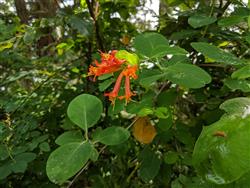 | - The book “Plants of the Pacific Northwest Coast”, Pojar & Mackinnon
- King County Native Plant Guide: https://green2.kingcounty.gov/gonative/index.aspx
|
Remove invasive species
The first step in any restoration project is to identify the invasive species on your property and come up with a plan to remove them. Invasive plants are plant species that can overtake native species in an ecosystem. Some invasive species are designated noxious weeds, which are especially harmful invasive plants that are monitored and controlled on a county, state, or federal level. Noxious weeds can fall into 3 different categories depending on the severity of the threat they pose to people, livestock, and the environment. For some noxious weeds the State or County may require you to remove them from your property. For more information about noxious weeds, please consult the Washington State Noxious Weed Control Board (WNWCB) or the Skagit County Noxious Weed Control Board.
One trend you may start to notice as you learn about invasive plants is that they are commonly found in peoples’ yards. While most people don’t plant invasive species intentionally, due to their attractive appearance many invasive plants are often overlooked by people who don’t know the damage they can cause. Unfortunately, these plants often escape their gardens and become invasive pests that threaten native ecosystems.
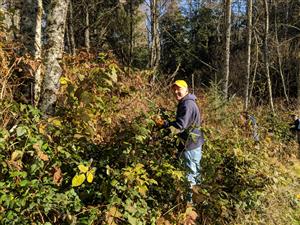 | By removing them from your yard and switching to non-invasive and native plants, you can help stop the spread of these invasive species into our natural areas. Below are a few common invasive species that you may have in your garden as well as information about how to remove them. Additionally, if an ornamental plant in your garden is spreading rapidly on its own, it’s more likely to escape and cause issues in natural areas. |
Be sure to monitor your garden for any plants exhibiting this behavior and remove any that do.
- Butterfly Bush: This invasive is a common garden plant that escapes peoples’ yards and makes its way to natural areas where it can take over. It is a common invasive in riparian areas and a threat to salmonids. Young plants can be hand pulled, and cutting flower heads before they produce seed can help prevent them from spreading. Please visit the WNWCB website page for more information on how to ID and remove this invasive.
- Yellow Archangel: Yellow archangel is a beautiful plant that can aggressively take over natural areas and is an increasing problem throughout Washington State. Hand pulling can be difficult for this plant as all root and stem fragments need to be removed and properly disposed of to prevent spreading. For information on how to remove and ID this invasive species, please visit the WNWCB website page for this plant.
- Spurge Laurel: This invasive plant is an evergreen shrub that threatens native forest habitat. It is also toxic to humans and animals and can cause skin irritation. Because of this, always make sure to gloves, long sleeves and pants when handling this plant. Smaller plants can be hand pulled, but larger shrubs may require more tools to remove them. Please visit the WNWCB website page for Spurge Laurel to learn how to ID it and how it can be removed.
- English Ivy: This invasive spreads aggressively and can take over forest understory and even full grown trees. Young vines can easily be hand pulled, but larger plants require more work and proper disposal of roots is necessary. Please visit the WNWCB website page for this plant to learn more.
- Scotch Broom: Scotch broom is a common sight along roadsides and in sunny, disturbed areas. It can easily take over open areas displacing native species. Young plants can be hand pulled or pulled with a weed wrench tool. Because scotch broom produces a large number of seeds, it is likely that is will come back for several years and will need to be tended into the future. Please visit the NWCB website to learn more about this plant.
- English Holly: This plant is not currently listed as a noxious weed, but is an invasive plant that has spread in natural areas across Washington State. Hand pulling of young plants is possible, but more mature plants may require other methods. Cutting English Holly can result in rapid re-sprouting of the plant, so try to remove the roots. Please visit the NWCB website to learn more about this plant.
- Knotweed: There are several different species of Knotweed that are invasive in Washington state. Knotweeds are especially problematic in riparian areas along creeks and rivers where they can crowd out native vegetation and impact salmon habitat. Removing Knotweed from your property is required in Skagit County. However, because even tiny fragments of Knotweed can regrow into a new infestation, effective removal of this plant and proper disposal of any part of the plant that you remove, can be difficult. Please visit the NWCB website to learn more about removing Knotweed.
Invasive plants often move into disturbed areas, such as logged areas in a forest, areas mowed along a road, or flooded areas. Keep an eye on disturbed areas to spot problem species early while they are limited and easier to control.
Plant native and non-invasive species
| Replacing invasive species in your yard with native alternatives can be incredibly beneficial for wildlife and the environment, and many of our native species are just as beautiful! However, deciding which plants are most appropriate and where to get them takes a bit of research. This brochure created by the Plant Materials Center in Skagit County is a great quick guide to help you determine what plants may be a good fit for your property. | 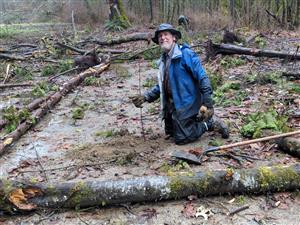 |
Luckily, there are several native plant nurseries in and around Skagit County. Not only are they a great place to get native plants, but they also have wonderful resources to help you choose the right plants and teach you how and when to plant them. The Washington Native Plant Society provides updated lists of where to buy native plants in your area. Additionally, the Washington State Noxious Weed Control Board put together this booklet that includes common invasive species and what native or non-invasive plants you can replace them with in your garden.
Increase wildlife habitat
Planting certain native species can make your yard more attractive to specific animal species. Additionally, the layout of your yard and inclusion of things such as bird baths, logs/stumps, and other features can improve habitat. Below are just a few resources that can help you get started on making your garden wildlife friendly! Additionally, you can get your yard certified as backyard habitat through the National Wildlife Federation.
Make a rain garden
A rain garden can help preserve our water resources, prevent runoff, and reduce pollution. This brochure by the Skagit Conservation District is a great introduction.
Compost
Composting at home has numerous benefits. Not only does it reduce the waste you send to landfills, but compost is a wonderful way to tend to your garden as an alternative to chemical fertilizers, and can even improve soil within tended gardens on your property. Think carefully about where to place compost piles - make sure to avoid impacting sensitive areas like wetlands. Skagit County provides some great tips for composting at home, and even offers workshops on occasion.
Additionally, it is important to note that compost is typically not a suitable way to dispose of invasive species. Click here for more information on this and how you can dispose of invasive plant fragments.
Soil in natural areas, outside of tended gardens, does not need compost – native plants are already well-suited to the native soils of our area. In forests and natural areas, just leave fallen native vegetation in place to decompose and create a healthy layer of plant litter (decomposing plant material). Plant litter, from tiny needles to entire trees, is beneficial for a wide array of native species. Click here to learn more about the importance of plant litter.
What is the best stewardship strategy for my property?
While any of the above ideas could be implemented on your property, some stewardship tactics and projects may be more or less beneficial depending on the location and characteristics of your property. Find the category that best describes your property below to find more detailed information and resources for how to manage it.
Forest
Whether you own a working forest or own forested land that you do not plan on harvesting, managing forested properties requires planning. Forests are incredibly important for wildlife and our water systems. Below we have listed a few helpful resources and organizations for you to consult as you start planning the stewardship of your forest.
Snags
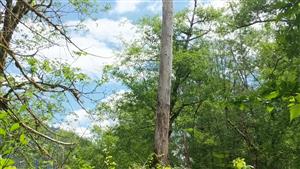 | Dead trees, often called snags, provide numerous benefits for wildlife, many of which depend on snags for their existence . However, when located on your property they can also create risk for landowners as they are more likely to fall or catch fire. While some snags may be far enough away from buildings that they don’t pose a threat, sometimes removal may be necessary. |
The Washington Department of Natural Resources, Skagit Conservation District, and local arborists can help you assess the risk associated with certain trees on your property and how to remove them if necessary.
• Washington Firewise
• Find an Arborist
Shoreline
If you live next to a body of water – be it the coast, a lake, river, or stream, there are special things you have to consider when stewarding your property. One of the most crucial considerations for shoreline properties is maintaining a vegetated riparian buffer. This is essentially an area with native vegetation between the body of water and the rest of your property or any other area with high human use or disturbance. Having native vegetation in this area provides habitat for wildlife and also helps protect the water quality of the adjacent body of water by filtering out pollutants, providing shade to maintain cooler water temperatures, and preventing soil erosion. Please consult the WSU Extension Shore Stewards Guide for Shoreline Living for additional information. This booklet provides wonderful, detailed information about the many factors to consider with shoreline living. We’ve highlighted just a few below, but strongly recommend using the booklet as a resource!
Freshwater Shorelines
Protecting our freshwater systems is extremely important. Not only do humans rely on clean water, but wildlife such as salmonids are also heavily dependent on having abundant cold, clean, and clear water. If you live on a fresh water shoreline, it is vital that you ensure you are managing your property to protect this resource. The above pamphlet lists a number of ways that you can steward your shoreline property, and even has an entire section devoted to freshwater systems.
Marine Shorelines
| If you live along the coast in Skagit County, the way you choose to manage your property will directly affect the Salish Sea and the many species that call it home. As most Skagitonians already know, the Salish Sea ecosystem provides habitat for a number of wildlife species, including the endangered Southern Resident Orcas. By stewarding your marine shoreline property, you can ensure that the Salish Sea continues to provide the necessary resources for all who depend on it – human and animal alike. | .jpg&size=300) |
While the above booklet has great advice for all shoreline habitat, the Washington Department of Fish and Wildlife has another great resource that talks more specifically about stewarding your property along the coast.
Beavers
| If you live along a shoreline, there’s a good chance you may encounter a beaver at some point. Beavers are well known for giving landowners headaches, but they are also incredible ecosystem engineers who play a vital role in our local environment. Learn more about living with beavers here. If you’d like to delve deeper, we recommend reading Eager: The Surprising, Secret Life of Beavers and Why They Matter by Ben Goldfarb. | .JPG&size=300) |
Urban
One of the best things you can do if you live in an urban area is provide habitat for wildlife. Urban areas often act as a food and habitat desert for many species due to the lack of vegetation, safe places away from high traffic human areas such as roads and sidewalks, and reduced connectivity to ideal habitat. By stewarding your urban garden, you can help create a safe oasis for wildlife such as birds, insects, and mammals that pass through or reside in your neighborhood. Please view the ways you can increase wildlife habitat in your urban garden listed above.
Agricultural
Agricultural properties play a huge role in providing the people of Skagit County with food. By protecting the natural resources on your property, you can ensure longevity of the success of your land while also protecting the many species that call Skagit County home.
The U.S. Department of Agriculture has compiled a number of resources to help you manage your agricultural property while protecting native ecosystems.
Other resources
Your property is unique and will require a unique stewardship plan that fits you and your land. Depending on the size/scale and property type you are restoring, it may be useful to seek out additional trainings and information. Below are some other resources that may also be useful to you.